How do you determine what universal converter to use?
When installing a universal converter, it must still meet the emission requirements of the vehicle and can not be chosen by size alone. By looking up your specific vehicle in the catalog or web site, you will find the recommended universal converter with the appropriate loading. If a universal converter is not listed for your specific application, please refer to the universal converter specifications guidelines.
What makes a converter become red hot and/or melt the brick (thermal melt down)?
Converters will get red hot when excess fuel is introduced directly into it, along with sufficient oxygen to burn the fuel. This is not a problem with the converter itself, but the result of a problem with the fuel system or ignition that allows unburned fuel to pass through the engine and then travel down into the converter. If the root cause is not corrected, the new converter will melt as well. Common causes of a melted converter are: 1) A three-way plus air vehicle running rich, and when the air is injected into the converter, the rear brick will melt as the excessive fuel now has enough oxygen to burn inside the converter, 2) Vehicle is running rich with an exhaust leak, and when the air is drawn into the exhaust pipe and is combined with the excess fuel, it will burn in the converter, 3) The vehicle has a misfire. When the air-fuel charge leaves the combustion chamber without firing, it will travel through the exhaust pipe and burn in the converter.
What has caused my converter to become plugged (loss of power)?
If a converter is operated too long at a high temperature, the substrate may “melt down” and turn into a solid mass inside the converter. The vehicle may seem sluggish as if there was a loss of power. Other causes might be: 1) upstream converter has broken up and the debris has clogged a down stream unit, 2) the support mat may have become damaged and no longer retaining the brick in the correct position, allowing the brick to shift and block the exhaust flow.
What is chemical contamination of a converter (poisoning)?
If a replacement converter fails after a short period of time, then the root cause of the original failure has not been addressed. Some causes are contamination by silicone based sealants, coolant leaks, oil blow by, high sulfur fuel, and/or rich fuel mixtures forming carbon deposits can quickly coat the substrate preventing it from working effectively.
What is the EPA policy on replacement converters?
In August, 1986, the U.S. Environmental Protection Agency issued new EPA converter guidelines for the construction, efficiency and installation of aftermarket converters. The converters listed in the Walker catalog have been designed and manufactured to meet the EPA policy and emission reduction requirements. For further questions in regards to using and installing an aftermarket converter, please refer to the following EPA document http://www.epa.gov/otaq/cert/factshts/catcvrts.pdf
What is a three-way converter?
A three-way converter (also known as oxidation/reduction converters) are designed to control levels of carbon monoxide, hydrocarbons, and oxides of nitrogen. Some three-way converters are equipped with an air injection tube, and this additional air, which comes from the air pump, assists the chemical reaction in the oxidation catalyst. Our converters all utilize three-way catalyst technologies, and will operate in a two-way mode (controlling hydrocarbons and carbon monoxide) on older vehicles requiring a two-way converter.
How do I determine if I have a California emissions vehicle?
To determine if a vehicle has California emissions, check the emissions sticker on the vehicle, which is located in the engine compartment. If the sticker states the vehicle meets California requirements, then the vehicle is equipped with California emissions. Click Here For Engine Family Number Information.
Can I remove a functioning converter?
No. You may not remove or replace a functioning converter.
Can I use a standard universal type converter on a vehicle with a diesel engine?
No. A diesel engine has different emission requirements and a gas engine converter will not function on a diesel engine.
Is there a dimensional difference between a 49 state legal converter which shows Federal or California options?
Vehicles licensed outside of California, but built to California emissions standards, may have a physical difference from a vehicle built to Federal emissions standards. (If your vehicle is manufactured to California emissions standards, it cannot use a converter that is cataloged as Federal only). You need to reference your vehicles emissions sticker before purchasing a Walker converter. A vehicle licensed in the State of California must use a CARB approved converter.
The internals of my catalytic converter have melted down after a few months of it being installed on my vehicle. Was my converter faulty from the factory?
No. Converter meltdown is primarily contributed to an engine misfire. The unused air and fuel resulting from an engine misfire will cause an intense fire inside the catalytic converter damaging it internally. Normal operating temperatures of a converter are 500-800° F, and up to 1200° F when the vehicle is under heavy load. To melt the catalytic converter’s substrate, the temperature inside the converter would have to exceed 2000° F.
Will replacing my converter with a new one eliminate the P0420/P0430 code from coming on?
There is no guarantee that replacing the converter will keep a fault code from coming back. If an engine performance issues exist, and it has not been repaired, the P0420/P0430 fault code may recur.
Why did my converter fail?
Typically converter failures fall in to one of the following categories:
Physical damage due to corrosion, or from the converter contacting a large object on the road surface.
Contamination – due to excessive oil consumption, internal coolant leak, or excessive carbon build up.
Melted substrate – due to engine misfires which lead to excessive converter temperatures.
Thermo quenching – hot converter is cold quenched when driving through deep water or into deep snow.
Converter aging/lack of engine maintenance – cycles of damaging engine conditions will eventually deteriorate converter performance.
Why is my “Check Engine” or “MIL” light indicating that I have a “P0420 “Low Converter Efficiency” code; does this mean the converter needs to be replaced?
A P0420 low efficiency code does not always indicate that the converter needs to be replaced. On newer vehicles a low efficiency code will can occur if the exhaust feed gases are not of the proper balanced to allow the converter to operate efficiently. An experienced emissions technician may be able to identify and resolve this concern with a scan tool, the most effective way for most technicians to diagnose this condition is through the use of a 5 gas analyzer.
Are there any steps my technician can take to prevent my new converter from failing prematurely?
Yes,
Since converters are designed to last the life of the vehicle the technician should identify and correct the root cause of the original converter failure.
The technician should make sure any other codes are corrected prior to installing the new converter. This is especially true for misfire, mass air flow, rich/ lean conditions, and O2 response rate codes.
Pressure check the cooling system to test for leaks which will contaminate the new converter.
Repair any exhaust leak that may be present. An exhaust leak may affect converter and O2 sensor operation.
Check O2 operation: The front sensor should have good frequency, amplitude, and response rate and average 450mv. The rear should be fairly steady at idle and above 450mv (typically 650-850mv).
If both of the above O2 sensor readings are not present, the vehicle should be checked with a 4 or 5 gas analyzer and repairs should be performed.
http://www.walkerexhaust.com/
 1 – STAINLESS STEEL BODY
1 – STAINLESS STEEL BODY
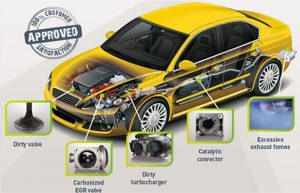 Cleans your engine
Cleans your engine Allows oxidation of CO (Carbon Monoxide) to less-harmful CO2 (Carbon Dioxide)
Allows oxidation of CO (Carbon Monoxide) to less-harmful CO2 (Carbon Dioxide)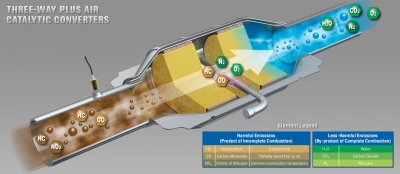
 Allows reduction of NOx (Nitrogen Oxides) to N2 (Nitrogen) and O2 (Oxygen)
Allows reduction of NOx (Nitrogen Oxides) to N2 (Nitrogen) and O2 (Oxygen)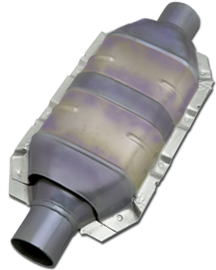 OVERHEATED, MELTED OR BROKEN CONVERTERS
OVERHEATED, MELTED OR BROKEN CONVERTERS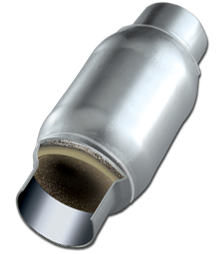 COATED / OIL-FOULED SUBSTRATE
COATED / OIL-FOULED SUBSTRATE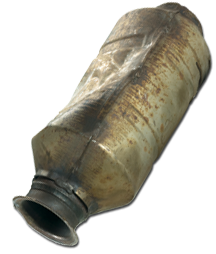 STRUCTURAL DAMAGE
STRUCTURAL DAMAGE
